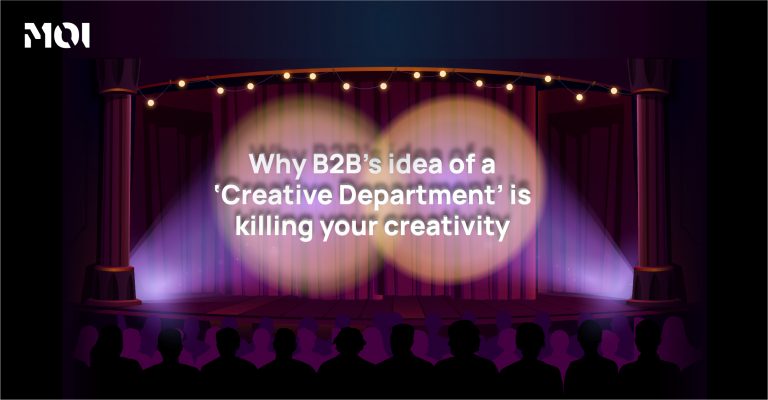
Brand matters, but it’s not what you think
B2B leaders love to talk about efficiency, product features, and sales funnels. But when the conversation shifts to brand, things tend to get fuzzy. Research tells us that brand is climbing up the B2B agenda—even edging out demand generation as a top priority. So, if more businesses recognise that brand matters, why does it still get such a bad rap?
The problem isn’t that brand doesn’t work in B2B—it’s that too many companies are getting it wrong. They see brand as something surface-level, an afterthought. Or worse, a vanity project. The truth is, brand is just as important in B2B as it is in consumer markets—if not more so. But it’s different, more complex, and requires a different approach. It’s not just about logos, slogans, or company colours. It’s about building trust, recognition, and emotional connection in a space where relationships are long-term and buying cycles are drawn out.
1. Why brand is essential in B2B
Let’s start with the 95:5 rule, a concept developed by the B2B Institute at LinkedIn. The rule says that, at any given moment, ‘95% of your target audience isn’t actively looking to buy.’ That means only 5% of them are in the market for what you’re selling. So, what’s the strategy for that 95%? You can’t target them with demand generation campaigns aimed at immediate conversion. Instead, this is where brand comes into play. Branding builds mindshare, positioning your company as the first choice when that 95% moves into the buying phase.
Without brand, you’re invisible. Worse, you’re replaceable. In an industry where differentiation can be a challenge, brand is what helps B2B businesses stand out from the competition, create long-term relationships, and earn a spot on a prospect’s “Day 1 list” when they’re ready to buy.
Reality Check: Brand is not just for consumer markets. In fact, in B2B, where the stakes are higher and decisions are more complex, brand can be even more important. You’re not just competing on price and features—you’re competing on trust, reliability, and the ability to deliver value over time.
2. Why it’s not as simple as you think
If only it were as easy as slapping a logo on a website and calling it a day. Branding in B2B is more nuanced. It has to align with long-term business strategy, touch every part of the organisation, and be embedded into every customer interaction—not just at the corporate communications level. The mistake many companies make is thinking of brand as a one-time project. They launch a new visual identity or rework their tagline and expect it to deliver magic.
Branding is a long-term investment. It’s about building mental availability in the minds of your audience, over time, and across every touchpoint. And the more complex the buying cycle, the more important brand becomes. When a decision involves multiple stakeholders, long-term contracts, and significant financial commitments, brand trust plays a critical role in tipping the scales.
3. Why brand often falls short
Here’s the kicker: many B2B companies feel let down by branding efforts. They don’t see the ROI, and the brand never seems to impact sales the way they expected. Why?
Misalignment. Too many companies see brand as an isolated exercise—a high-level initiative divorced from the everyday realities of demand generation, sales enablement, or customer retention. They invest in brand at the corporate altitude but fail to translate that investment into something tangible at the level where the business operates—on the ground, with prospects and customers.
In our work with B2B companies, especially in tech, we’ve seen this gap play out repeatedly. Leaders get sold on a shiny new brand idea, but the execution fails to connect with their sales teams, marketing initiatives, or customer needs. Brand gets labelled as a “vanity project” because it never reaches the people responsible for moving deals forward.
4. How to approach brand so it delivers
So, how do you fix this? The answer lies in understanding that brand is integral to the growth engine, not a cosmetic upgrade. At MOI, we’ve developed the Not-so-B2B Growth Engine which integrates brand into the entire marketing and sales cycle. Here’s how to make it work:
Align brand with demand generation
Too often, companies separate brand-building efforts from their demand gen activities. Don’t. Your brand should work hand-in-hand with demand generation, increasing the effectiveness of lead nurturing, making your marketing more memorable, and creating trust early in the funnel.
Embed brand into sales
Brand isn’t just about marketing—your sales team needs to live it too. Sales reps aren’t just selling products; they’re selling the story, the values, and the trust that your brand represents. Equip them with the messaging and tools that let them lean on the brand in their conversations.
Get internal buy-in
If your people don’t believe in your brand, your customers won’t either. Branding isn’t just an external exercise—it has to resonate internally, especially with those on the front lines. Get your employees involved and make sure they understand the role brand plays in every interaction with a customer.
Consistency across channels
Your brand must be consistent across all touchpoints. Whether it’s a trade show booth, a whitepaper, or a cold call, every experience should reflect your brand’s core values and messaging. Inconsistency erodes trust and leaves prospects confused about what your company stands for.
Measure what matters
Brand doesn’t deliver instant results, but that doesn’t mean you can’t track its impact. Instead of focusing on short-term metrics like immediate conversions, track brand health over time—awareness, consideration, preference, and trust. When the 95% move to the 5%, you’ll see the results.
5. Why do companies continue to overlook the power of brand?
So why do so many companies still dismiss branding? Simple—it’s misunderstood. There’s a belief that B2B buyers are driven purely by logic and that branding is an emotional play only relevant in consumer markets. There’s also the common misconception that branding is all about visuals, logos, and colours—a superficial add-on that doesn’t impact the bottom line.
In reality, brand-building in B2B is about creating long-term differentiation in an increasingly crowded market. It’s about building trust and credibility—two things that take time, effort, and consistency.
But too many businesses focus on short-term sales tactics, expecting branding to be a quick fix. When they don’t see immediate results, they blame the concept of branding rather than their execution.
6. Conclusion: Brand is the Long Game
The 95:5 rule makes it clear: brand building is not an expense—it’s a long-term investment. It’s the key to staying top-of-mind with your audience when they’re not ready to buy, and it’s the deciding factor when they are. B2B companies that fail to grasp the importance of brand are missing out on their biggest growth lever.
Brand is not a distraction or a vanity project. It’s your ticket to long-term success. And if you approach it the right way—integrating it into your demand gen, sales, and customer experience—it will deliver the results you need, time and time again.


